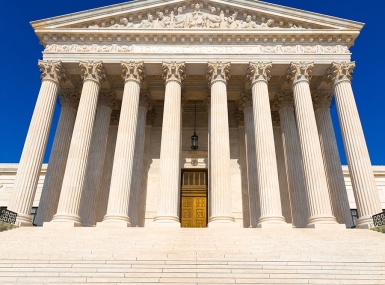Share
Line: | @NACoTweets: "Triple cliff" face-off in the works for Congress http://bit.ly/1FzDpg8 |
When members of Congress return to Washington from their August recess on Sept. 8, they will immediately face several crucial deadlines. One is the beginning of the new fiscal year on Oct. 1, by which date Congress and President Obama must come to an agreement on an appropriations package that will fund government programs in FY16.
Failure to reach an agreement could lead to a government shutdown, though congressional leaders, including Senate Majority Leader Mitch McConnell (R-Ky.) and Speaker of the House John Boehner (R-Ohio), have expressed confidence that no shutdown will occur.
A second major deadline looms at the end of October to raise the debt ceiling and prevent the United States from defaulting on its loans. The third deadline is the expiration of MAP-21, which funds the nation’s investment in surface transportation infrastructure, on Oct. 29. Congress passed a three-month extension of MAP-21 earlier this summer in hopes of buying enough time to reach a long-term deal. These deadlines together have been coined the “triple cliff.”
Past debates over the three issues have been marked with tension, sometimes leading to missed deadlines and last-minute deals. But action to avoid this “triple cliff” must be taken quickly since the Senate is only in session for 60 more days this year and the House shorter still with only another 43 days.
Here’s a closer look at the cliffhangers.
FY16 Appropriations
Although the House has passed six of the 12 individual appropriations bills for FY16, the Senate has yet to pass any. Further complicating matters: While both chambers have completed the committee process, there have been major disagreements between the leaders of each chamber and between Democrats and Republicans. Already, battles over defense spending and the removal of sequestration cuts, as well as over provisions in the Department of Interior Appropriations Bill (H.R. 2822) relating to the display of the Confederate flag, have delayed the appropriations process.
At the beginning of the 114th Congress, congressional leaders stated their commitment to follow the standard procedure for appropriations bills, which involves considering and voting on each measure separately.
However, time is quickly running out and the new fiscal year begins Oct. 1. As a result, it appears as though Congress might seek to pass another omnibus package that includes all 12 individual appropriations bills.
Typically, an omnibus package is easier to pass due to its size, but battles over funding levels are expected. For instance, President Obama and many congressional Democrats have indicated opposition to any appropriations bill that increases defense spending above sequester levels but does not match, dollar for dollar, an increase in domestic spending.
Republicans, on the other hand, are generally wary of domestic spending increases but seek to boost defense spending. Boehner, recognizing the potential for complications, has acknowledged that a short-term continuing resolution (CR) might be necessary in order to come to a final agreement. A CR would maintain all funding at current levels until a new appropriations package can be passed.
Transportation Funding Cliff
After another short-term extension of the surface transportation law known as MAP-21 passed July 30 — the third MAP-21 extension since 2012 — funding is set to expire again on Oct. 29. The biggest challenge confronting the passage of a long-term transportation reauthorization bill has long been, and continues to be, how to pay for it. For the last few years, the main source of funding for federal highway and transit programs — the Highway Trust Fund — has been teetering at the edge of insolvency.
There are several options for raising revenue for the trust fund. One option is to increase the federal gas tax, which currently stands at about 18 cents per gallon. Congress has not increased the federal gas tax since 1993, even as inflation and increased fuel efficiency have decreased the value of the tax. Meanwhile, since 2000, construction costs for highways and bridges have increased 44 percent despite a lower 35 percent increase in inflation.
Other options being considered by Congress include repatriation of overseas corporate profits and a tax on vehicle-miles traveled. While Congress is unlikely to agree on a long-term funding solution that is tied to the gas tax or to vehicle-miles traveled, repatriation is still an option and Congress is looking at other offsets that are not tied to transportation. Failure to reauthorize and provide funding, perhaps through one or a combination of these measures, would pose a severe threat to county infrastructure investments.
Despite the funding challenges, the Senate was able to pass a long-term measure at the end of July before adjourning for recess. The DRIVE Act (S. 1647), would reauthorize federal highway and transit programs for six years, though it would only provide enough additional revenue to pay for three years of funding.
However, House leadership has indicated they will not take up the DRIVE Act as written. They plan to develop their own piece of legislation that reflects their chamber’s priorities. They then plan to take their own bill to conference with the Senate where the two chambers work out any remaining differences.
Instead, the House passed the three-month extension, which the Senate agreed to pass with the stipulation that those three months would be sufficient time for the House to finalize and pass a long-term bill that could be conferenced with the DRIVE Act this fall.
A detailed overview of NACo’s surface transportation priorities can be found on the Transportation Steering Committee home page on NACo’s website, www.naco.org.
Debt Limit Cliff
The third deadline concerns the debt ceiling. According to Secretary of the Treasury Jack Lew, the debt ceiling will likely need to be raised again before the end of October. Treasury is currently using “extraordinary measures” to ensure that the United States can continue paying its bills, but these measures can only buy so much time.
Debt ceiling clashes have become commonplace in recent years; Congress last reset the debt ceiling in March 2015 to $18.11 trillion, after raising it at least six previous times since 2010.
In 2013, the debt ceiling was finally raised after the government had been shut down for more than two weeks. In 2011, the debt limit deal resulted in the sequestration or automatic, across-the-board spending cuts that are still a major point of contention in Congress.
In fact, the sequester, as it’s become known, now threatens the FY16 appropriations process, particularly as it relates to defense spending.
Many Democrats are calling for a “clean” reset of the ceiling, while many Republicans are looking to use the debt ceiling battle as a way to achieve spending cuts. It remains to be seen which of these paths Congress will ultimately take.



